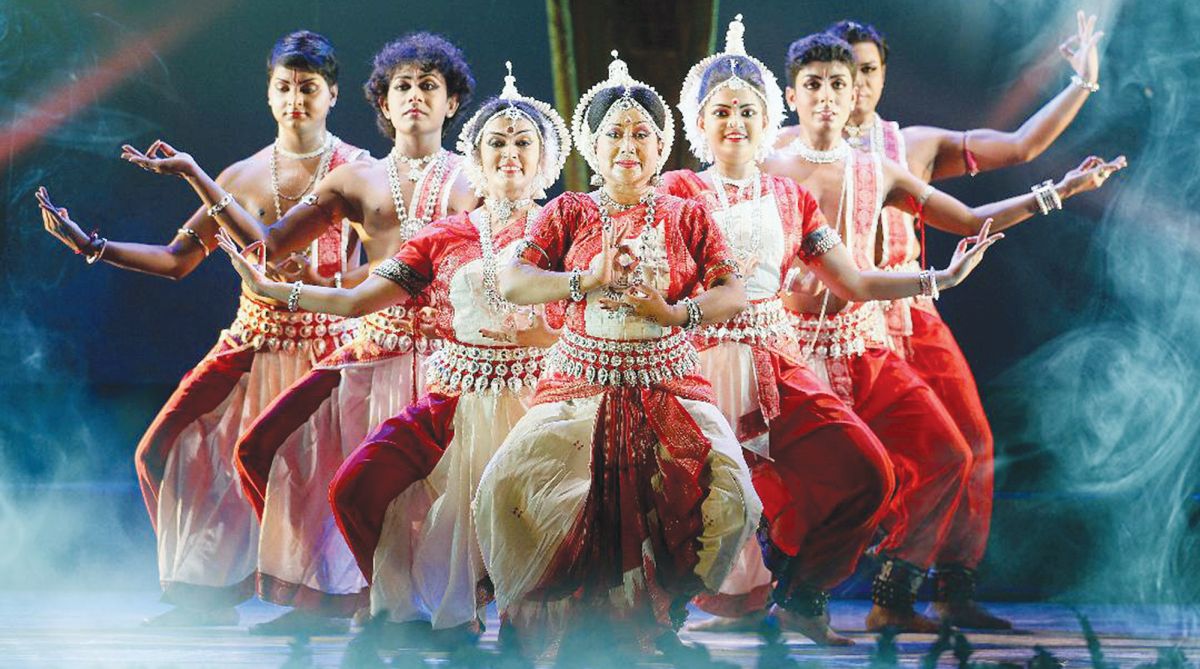An essence of glory
City dwellers were enthralled by the creative dance drama that was aesthetically executed at a soiree recently.
A disparate array of classical performances showcased the bounty of India’s ancient philosophical ideas and mythological stories.

Bhattacharya and her disciples.
Artistic director Maya Bhattacharya of Nrityangana celebrated the 23rd anniversary of her dance institution with great pomp and show, presenting many of her own choreographic works, besides those of her guru Kelucharan Mohapatra.
Bansuri was a fine piece as it aesthetically incorporated episodes from Radha and Meera’s life to showcase the power of the flute played by Krishna. It was a beautiful concept highlighting the love of Radha for Krishna and the sacrifices made by Meera for Krishna. However this reviewer feels that Meera was also driven by devotional love or bhakti sringar into doing what she did. To brand her actions as mere sacrifice is a bit simplistic.
Advertisement
Bhattacharya’s creativity lay in the fact that she made use of kirtan and bhajans for the depiction of her unique concept. Scripted by Punya Darshan Gupta, there was immense scope in it to choreograph a rich and spectacularly heart-touching piece.
Advertisement
A well-trained group of dancers won over rasikas with their renditions. Bhattacharya in the role of Radha displayed bhakti sringar while the role of Meera was performed by Shraboni Bagchi. Suman Kundu and Rahul Naskar danced with their khols much to the delight of the audience. Biswajit Sarkar’s music and Uttio Jana’s light designs added to the fineness of the piece.
Next, Bhattacharya successfully took up the challenge of performing Kuru Yadu Nandana, one of the oft-performed abhinaya pieces from Jayadeva’s Geet Govinda, where Radha urges her lover Krishna to take her back to what she was before spending an amorous night with him. It was a sensitive portrayal of a theme where complete surrender to the supernatural soul was depicted symbolically. She scored well in this.
***
Malasree celebrated their annual festival of dance under the aegis of Arpita Venkatesh, where Guru Aloka Kanungo’s disciples from Shinjan Nrityalaya — Asmita Mohanty, Swaralipi Roy and Urjasee Basak performed the inaugural dance.
Bharatanatyam dancer Mohul Mukherjee performed Bhavyami Gopalabalam and Shakti, choreographed by Guru Thankamani Kutty. Simhendra Pallavi choreographed by Sutapa Talukdar was performed by Payel Mazumder Mandal, Subhasish Acharya, Madhuparna Mondal and Sourav Samanta.
Madhuri Majumdar’s students Sagni Majumdar, Sahana Chawdhury and Subha Jena performed Shiva Stuti and tarana in Kuchipudi style. Odissi dancer Priyanaka Banerjee performed Mohana Pallavi — a pallavi and an abhinaya piece choreographed by Pushpita Mukherjee. Kathaka Nilopa Maitra gave glimpses of the rich heritage of Kathak.
A jugalbandi in Manipuri and Odissi by Nandanik troupe and Malasree repertory members was the grand finale. In Manipuri, the dancers were Paushali Chatterjee, Priyanka Talukdar, Malabi Chowdhury and Shatabdi Mahalanabish while Arpita Venkatesh, Moumita Dutta, Madhurima Das and Rajarshee Chakraborty took part in their own Odissi style.
Their first piece was Mridang Manjira where Manjira was in Odissi while Pung Cholom was of course Manipuri’s unique piece. Then they performed Tanum Pallavi, a pure dance piece on the tanum composed by Guru Bipin Singh. Odissi performer Arpita Venkatesh’ attempt to showcase most of the classical dance forms of India in one platform was commendable.
***
Ananta or infinite performed at the Satyajit Ray auditorium of ICCR, Kolkata. Arnab Bandyopadhyay’s meticulously choreographed work made use of the techniques of Odissi along with creative movements. In music too, the use of both the classical genre as well as other kinds along with Vedic chanting was innovative.
The soulful music of classical vocalist Subhadra Desai gave substance to the drama. The narrative for this performance focused on the theme of creation, which touches upon the five elements. According to Sanatan Dharma, the five physical elements is the basis of all cosmic creation.
Those elements have different characteristics and account for different kinds of human experience. Translating them into a story told through dance required creative imagination and Bandyopadhyay was more than successful in that.
The audience was schooled to understand that the Earth or Prithvi is both eternal and perishable. Agni (Fire) is also supposedly the guardian of the universe. Through the vocabulary of dance, Bandyopadhyay displayed that the five elements are associated with the senses.
Ananta was an exploration into some of the most profound philosophical concepts from the ancient Vedas and Upanishads. It is a new venture for the well-known Odissi dancer Bandyopadhyay. The piece scripted by Sreyasi Dey was set to a composition of Sandipan Ganguly.
Advertisement